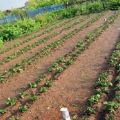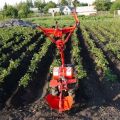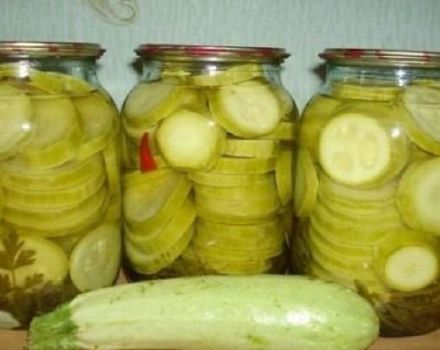How to properly care for potatoes for a good harvest
To make the potato harvest happy with the quantity and quality, it is not enough to plant it in the ground. Potatoes need regular care, in addition to hilling, watering, weeding, pest control and other measures are needed to guarantee a 100% harvest that will be well stored for a long time.
Potato care rules
Landing is not the most time consuming procedure in the scheme growing potatoes.
Physical effort will be needed during:
- weeding;
- hilling;
- loosening;
- cleaning.
High-quality and sharp tools greatly facilitate routine physical work. There are many tools for caring for potatoes. There are hand tools and mechanized equipment. For a good harvest, balanced fertilizers and timely watering are needed. Top dressing and irrigation should be carried out based on the recommendations that the manufacturer gives in the description for the variety.
Watering potatoes
In regions where it rains with enviable regularity, the soil is always moist and the potatoes do not need to be watered. But not all growers are lucky. In many regions of the Russian Federation, summer rains are rare, so irrigation is needed.
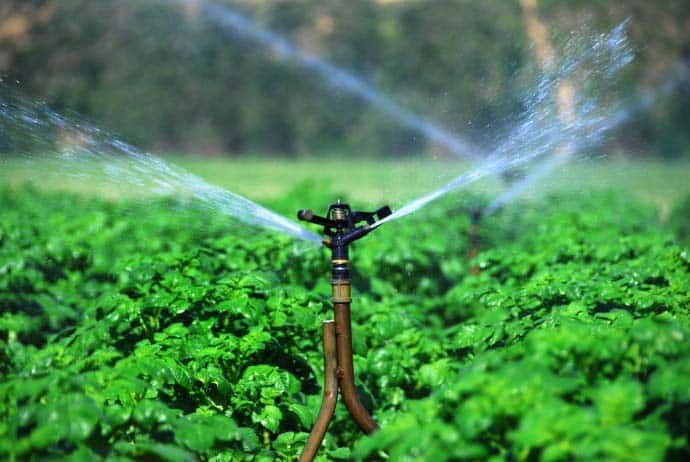
They are needed during flowering. When potato bushes bloom, tubers begin to form in them and the lack of moisture in the soil reduces their number. There are potato varieties bred for arid regions, but most species require moisture.
In the south, potato fields are watered once a week; in the northern latitudes, it is sufficient to irrigate once every 2 weeks.
An approximate scheme for watering potatoes:
- 3 weeks have passed since planting, the tops have grown by 10 cm - the time for the first watering;
- buds appeared - it's time to water the potatoes a second time;
- the roots began to grow actively, which means that you need to water the potatoes for the third time.
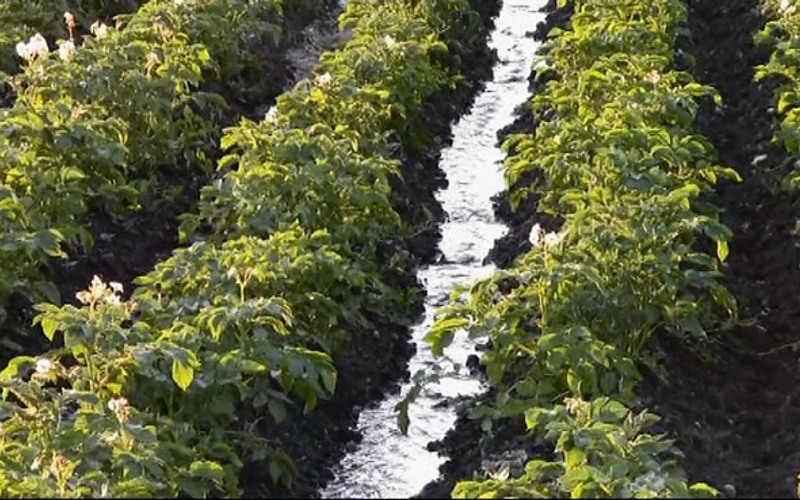
How to water?
Several irrigation systems have been developed and applied in practice, each vegetable grower chooses the most practical and effective one for himself:
- sprinkling;
- into furrows;
- using a drip irrigation system.

The most common and cheapest way of watering is by sprinkling. Watering is carried out manually with a watering can or a hose.
The method has disadvantages:
- irrational use of water;
- ingress of moisture on the leaves and stems, which can stimulate the development of late blight;
- decrease in the effectiveness of insecticides due to their washing away during watering.
Irrigation in the furrow leaves the tops dry, moisture flows directly to the root of the plant.
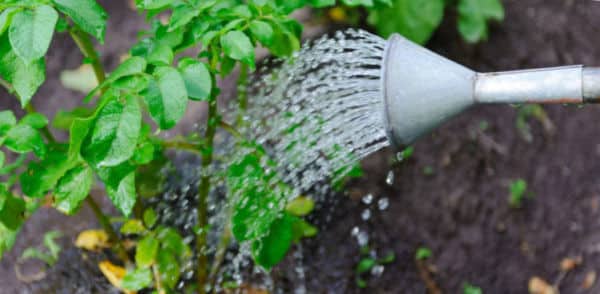
Important disadvantages of the method:
- water consumption is not justified large;
- the top layer of soil is compressed, which reduces the amount of oxygen supplied to the tubers.
Drip irrigation system
The drip irrigation system deserves special attention, its popularity is growing. It is effectively used when growing any kind of vegetables and ornamental crops in the garden. With a correctly selected irrigation scheme, high-quality equipment, each plant receives moisture right under the root, water is consumed exactly as much as the plant needs at this stage of development.
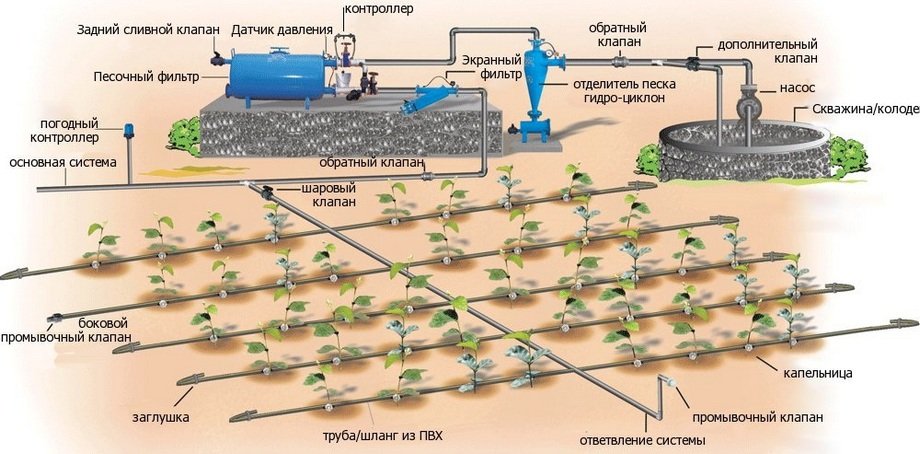
Advantages of the method:
- reduced water consumption;
- potatoes are less likely to get sick;
- the volume of physical labor is reduced;
- you can add fertilizers to the water for irrigation in the required concentration;
- there is no need to loosen the aisles, as no crust formation occurs during drip irrigation.
Loosening
Tubers develop only in loose soil. The first loosening procedure is carried out after the appearance of the first shoots and is repeated until the foliage closes. The soil is loosened both in the aisles and around the bushes.
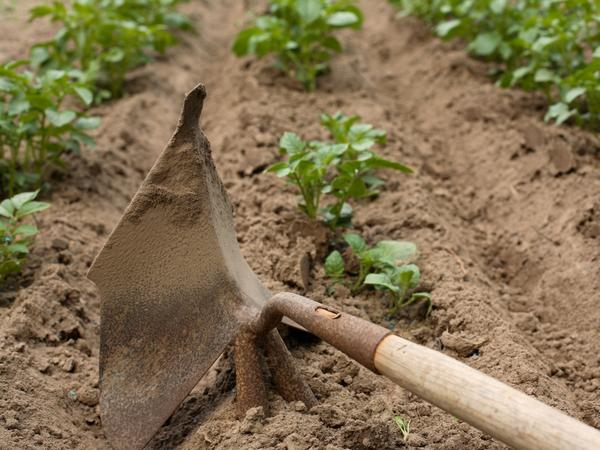
Loosening depth 3 cm, the frequency depends on the soil structure. For loose, light soils, several treatments per season are enough. Clay and loamy soils must be loosened after each rain (watering).
Harrowing potatoes
Harrowing is also loosening, only it is carried out with the help of special mechanisms.
Harrowing is carried out when growing potatoes on an industrial scale.
The procedure is carried out several times per season. In addition to loosening the soil, weeds are removed during harrowing.

Weeding potatoes
Without weeding, potatoes will overgrow with weeds and there will be no good harvest. Weeds are removed by hand, pulling them out of the bushes. Most of the weeds are destroyed during loosening, hilling, harrowing.
Hilling potatoes
This is one of the main points in potato care. Without hilling, there will be no full formation of tubers. Raking up the soil to the potato stalks, they improve oxygen access to the roots, create conditions for the formation of tubers from stolons. There are several ways of hilling.
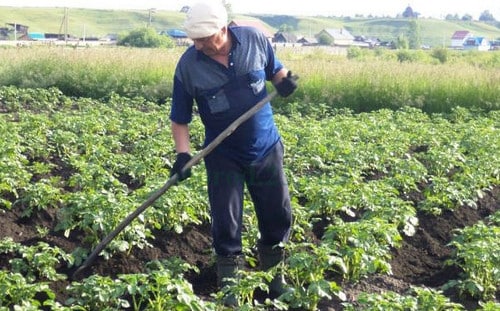
Classic hilling
With the classic hilling on potato rows, soil is scooped up on both sides. The tops of each bush are sprinkled with earth. A groove (furrow) is formed between the rows into which water is then allowed to irrigate.
Fan hilling
With the help of rolling hilling, the yield of potatoes is increased. The earth is shoveled into the center of the bush, while pushing the tops and improving its illumination. Some summer residents prefer not to cover the bushes with soil, but lay dry grass or straw in the center. It has been proven that this method of hilling increases the yield by 2 times.
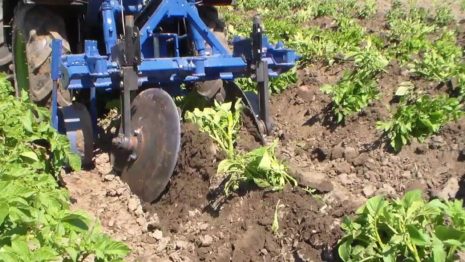
High hilling of potatoes
It makes sense to use this type of hilling when growing late varieties of potatoes. The high ridges increase the number of tubers in the nest and their size. For early and ultra-early varieties, this method is unacceptable; they need to be piled low.
Top dressing for potatoes
During planting potatoes you can add a special mineral fertilizer for potatoes to the hole; there are a lot of them on sale now.
Almost all fertilizers are produced in the form of granules, which contain the necessary set of nutrients.
The granules must be mixed with the ground, and then put the tuber in the hole, sprouts up. If there is wood ash, then you can pour it directly on the potato or a handful or 1-2 tablespoons.
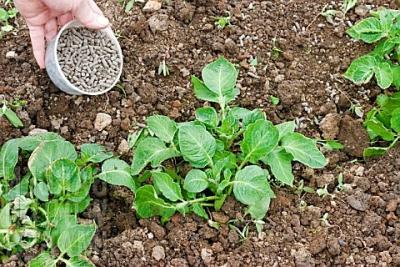
When potatoes are planted for many years in one field, the land is depleted, so organic (humus, compost) and mineral fertilizers are required annually. Sow green manures in autumn Sow green manures in autumn - vetch, rye.
In summer, do not forget about feeding. You can stick to the standard scheme:
- feed with ammonium nitrate when the tops grow up to 10-15 cm;
- when the first inflorescences appear on the bushes, feed the second time, use the ash infusion (a glass on a bucket of water) and add potassium sulfate (1 tbsp. l.) to it;
- with the active formation of tubers, pour each bush with a solution of slurry with the addition of 1 tbsp. l. superphosphate.
Care of potatoes during growth
We have considered all the activities that potatoes need during growth. In July, the bushes close up, so you no longer need to huddle them. It is easier to care for potatoes at this time. It is necessary to ensure that pests or signs of late blight do not appear on the bushes, follow the irrigation and feeding scheme.
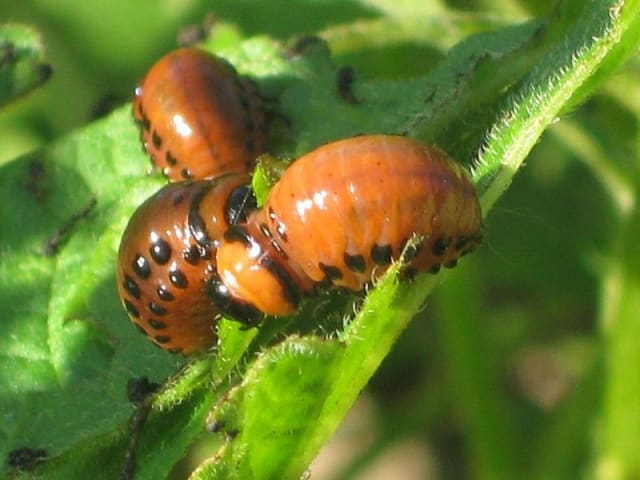
Growth regulators for potatoes
Increase the yield of potatoes you can use growth regulators. Agronomists recommend using:
- Epin-Extra.
- Zircon.
- Siliplant.
Protection from pests and diseases
The most dangerous pest of potatoes is the Colorado potato beetle and its larvae. With a moderate number of pests, they are harvested by hand, and the bushes are treated with infusions of wormwood or celandine. In case of severe infection, insecticides are used to treat late and medium late varieties. Early ripening varieties are not treated with chemistry.
High-quality and sharp tools greatly facilitate routine physical work. There are many tools for caring for potatoes. There are hand tools and mechanized equipment. For a good harvest, balanced fertilizers and timely watering are needed. Top dressing and irrigation should be carried out based on the recommendations that the manufacturer gives in the description for the variety.
Watering potatoes
In regions where it rains with enviable regularity, the soil is always moist and the potatoes do not need to be watered. But not all growers are lucky. In many regions of the Russian Federation, summer rains are rare, so irrigation is needed.

They are needed during flowering. When potato bushes bloom, tubers begin to form in them and the lack of moisture in the soil reduces their number. There are potato varieties bred for arid regions, but most species require moisture.
In the south, potato fields are watered once a week; in the northern latitudes, it is sufficient to irrigate once every 2 weeks.
An approximate scheme for watering potatoes:
- 3 weeks have passed since planting, the tops have grown by 10 cm - the time for the first watering;
- buds appeared - it's time to water the potatoes a second time;
- the roots began to grow actively, which means that you need to water the potatoes for the third time.

How to water?
Several irrigation systems have been developed and applied in practice, each vegetable grower chooses the most practical and effective one for himself:
- sprinkling;
- into furrows;
- using a drip irrigation system.

The most common and cheapest way of watering is by sprinkling. Watering is carried out manually with a watering can or a hose.
The method has disadvantages:
- irrational use of water;
- ingress of moisture on the leaves and stems, which can stimulate the development of late blight;
- decrease in the effectiveness of insecticides due to their washing away during watering.
Irrigation in the furrow leaves the tops dry, moisture flows directly to the root of the plant.

Important disadvantages of the method:
- water consumption is not justified large;
- the top layer of soil is compressed, which reduces the amount of oxygen supplied to the tubers.
Drip irrigation system
The drip irrigation system deserves special attention, its popularity is growing. It is effectively used when growing any kind of vegetables and ornamental crops in the garden. With a correctly selected irrigation scheme, high-quality equipment, each plant receives moisture right under the root, water is consumed exactly as much as the plant needs at this stage of development.

Advantages of the method:
- reduced water consumption;
- potatoes are less likely to get sick;
- the volume of physical labor is reduced;
- you can add fertilizers to the water for irrigation in the required concentration;
- there is no need to loosen the aisles, as no crust formation occurs during drip irrigation.
Loosening
Tubers develop only in loose soil. The first loosening procedure is carried out after the appearance of the first shoots and is repeated until the foliage closes. The soil is loosened both in the aisles and around the bushes.

Loosening depth 3 cm, the frequency depends on the soil structure. For loose, light soils, several treatments per season are enough. Clay and loamy soils must be loosened after each rain (watering).
Harrowing potatoes
Harrowing is also loosening, only it is carried out with the help of special mechanisms.
Harrowing is carried out when growing potatoes on an industrial scale.
The procedure is carried out several times per season. In addition to loosening the soil, weeds are removed during harrowing.

Weeding potatoes
Without weeding, potatoes will overgrow with weeds and there will be no good harvest. Weeds are removed by hand, pulling them out of the bushes. Most of the weeds are destroyed during loosening, hilling, harrowing.
Hilling potatoes
This is one of the main points in potato care. Without hilling, there will be no full formation of tubers. Raking up the soil to the potato stalks, they improve oxygen access to the roots, create conditions for the formation of tubers from stolons. There are several ways of hilling.

Classic hilling
With the classic hilling on potato rows, soil is scooped up on both sides. The tops of each bush are sprinkled with earth. A groove (furrow) is formed between the rows into which water is then allowed to irrigate.
Fan hilling
With the help of rolling hilling, the yield of potatoes is increased. The earth is shoveled into the center of the bush, while pushing the tops and improving its illumination. Some summer residents prefer not to cover the bushes with soil, but lay dry grass or straw in the center. It has been proven that this method of hilling increases the yield by 2 times.

High hilling of potatoes
It makes sense to use this type of hilling when growing late varieties of potatoes. The high ridges increase the number of tubers in the nest and their size. For early and ultra-early varieties, this method is unacceptable; they need to be piled low.
Top dressing for potatoes
During planting potatoes you can add a special mineral fertilizer for potatoes to the hole; there are a lot of them on sale now.
Almost all fertilizers are produced in the form of granules, which contain the necessary set of nutrients.
The granules must be mixed with the ground, and then put the tuber in the hole, sprouts up. If there is wood ash, then you can pour it directly on the potato or a handful or 1-2 tablespoons.

When potatoes are planted for many years in one field, the land is depleted, so organic (humus, compost) and mineral fertilizers are required annually. Sow green manures in autumn Sow green manures in autumn - vetch, rye.
In summer, do not forget about feeding. You can stick to the standard scheme:
- feed with ammonium nitrate when the tops grow up to 10-15 cm;
- when the first inflorescences appear on the bushes, feed the second time, use the ash infusion (a glass on a bucket of water) and add potassium sulfate (1 tbsp. l.) to it;
- with the active formation of tubers, pour each bush with a solution of slurry with the addition of 1 tbsp. l. superphosphate.
Care of potatoes during growth
We have considered all the activities that potatoes need during growth. In July, the bushes close up, so you no longer need to huddle them. It is easier to care for potatoes at this time. It is necessary to ensure that pests or signs of late blight do not appear on the bushes, follow the irrigation and feeding scheme.

Growth regulators for potatoes
Increase the yield of potatoes you can use growth regulators. Agronomists recommend using:
- Epin-Extra.
- Zircon.
- Siliplant.
Protection from pests and diseases
The most dangerous pest of potatoes is the Colorado potato beetle and its larvae. With a moderate number of pests, they are harvested by hand, and the bushes are treated with infusions of wormwood or celandine. In case of severe infection, insecticides are used to treat late and medium late varieties. Early ripening varieties are not treated with chemistry.
Diseases of potatoes (late blight, rot) are treated with biological products:
- Guapsin.
- Agate-25K.
- Immunocytophyte.
Describing potato care methods will help you grow a good potato crop.




